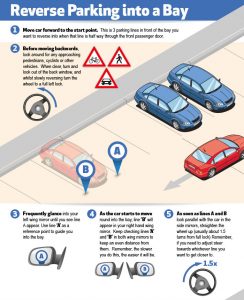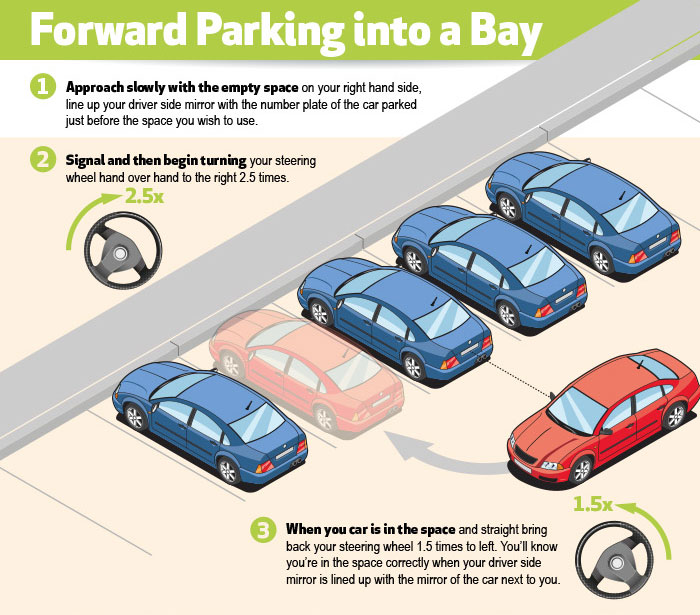Contents
Bay parking can be, for many, a tricky manoeuvre to learn and one that is often dreaded on the practical driving test. However, with the correct instruction and a lot of practice, it is something you can master and even come to take satisfaction in.
Fortunately, for some, you will only be asked to bay park if the driving test centre has private parking bays – but don’t let that make you complacent, it has been known for examiners to travel to another test centre (if there is one close by) so that this manoeuvre can be examined.
Being fully prepared for whatever your practical driving test may throw at you is essential to secure that passing mark and be rewarded with your full driving license. In this article, we will run through some instructions on how to bay park, no matter what the space, so you can make sure you have the theory behind the manoeuvre before you put it into practice in your driving lesson.
What is Bay Parking?
First off, bay parking is essentially parking your car in a car park – so something that you will probably be doing regularly in your day to day life. In this manoeuvre, you need to make sure you are between the marked white lines that outline the space.
There is no one, set, correct way of doing the bay parking manoeuvre, but the examiner will be checking for your accuracy (how well you parked in between the white lines), observation (making sure you are fully aware of your surroundings as you park), and control (keeping the car at a safe speed while parking using the clutch and effective steering).
How to Bay Park
Unfortunately, there is no ‘one size fits all’ method for bay parking as car parks have different layouts and the position of different spaces in the car park require different approaches. However, you can learn some key techniques which will be adaptable for whatever situation you are in. It is important to note that it is generally safer to reverse into bays as it gives you more accuracy – plus, it is safer to leave the space when it’s time to go. Here we outline the methods you need to put into practice when bay parking.
Reverse Bay Parking on Left

This technique is very similar to how you would reverse into a sharp road on the left so you may already be familiar with the methods required.
Select the Space
Select a car park which is pretty empty so you can comfortably practice this manoeuvre and allow yourself the chance to make mistakes (i.e. make sure there are no other cars around!). As you make progress you can build up to practising in busier car parks.
Pull up a couple of bays past the space
Make sure you practice mirror – signal – manoeuvre and pull up the car a few spaces ahead of the space you wish to reverse into.
Prepare
To get the car ready put your clutch down, put the gear in reverse and find the biting point of the clutch. If the space is downhill, make sure you practice brake control carefully.
Observe
Next, check around you to make sure it is safe to start reversing. Check for any other vehicles that might be coming towards you and keep an eye out for any potential hazards that could develop such as pedestrians walking towards their parked cars that may need to walk past and require you to stop. You need to keep checking for hazards throughout the bay park, but your main focus will be the back window – as you will be reversing.
Manoeuvre
 It’s now time to start reversing:
It’s now time to start reversing:
- Find the Point of Turn – Reverse straight back and find the point of turn, while this is different for each car a general rule of thumb is to identify the closest of the bays to you and line this up in the back left window.
- Observe – Once the point of turn is identified make sure you check your surroundings before starting to reverse. As the front of your car will be swinging out at this point it is essential that you make sure there are no other oncoming vehicles or pedestrians. In your driving test, you will also need to be aware of other learner drivers taking their test.
- Reverse and Turn Steering Wheel to Full Lock Left – When you are confident it is safe to start reversing start to move slowly backwards whilst at the same time quickly turning your steering wheel until it is on full lock left (normally around one and a half turns to the left). In this part of the manoeuvre slow steady movement and quick steering is essential. At this point, your car will be moving slowly into the space – make sure you are always checking around you as you move.
- Check your Wing Mirrors – Once the car is almost straight in the parking bay look in your wing mirrors to check your position. You know you are on your way to success if you can see the bay lines in each of your wing mirrors.
- Straighten Up – When you are almost straight in the bay you need to start straightening up. You can do this by taking off the full left lock so that the steering wheel is back to its original position. It is important that the car is not hanging over the front of the parking bay so you may need to reverse a little more into the space – make sure you use your mirrors as you do this.
- Adjust – If necessary, you may need to adjust the position of the car, you can do so by making sure it is safe to move and then driving a little out of the space and then reverse back in again. If more major adjustments are required it is best to start again and identify where the problem occurred. It could be that you need to adjust the point of turn – if your car was too far to the left of the space go a little further on your point of turn this time, whereas if you were too far right, stop a little sooner.
Reverse Bay Parking on Right

If you are required to park in a bay on the right then you can use the same instructions as above but make sure you look over your right shoulder and through the driver’s window so that you can identify the correct point of turn.
Forward Bay Parking

How to park in an angled bay
Parking in an angled bay can be a little trickier, you can use the same step-by-step technique outlined above but be aware that the point of turn is likely to be different. It can be harder to identify the point of turn so it is a good idea, at first, to get the help of your instructor to help you locate the best place to start turning the steering wheel. With practice, it will get easier to locate this spot yourself.
When parking in an angled bay you will also need to straighten up earlier than when parking in a straight ninety degrees bay – so make sure you are looking in your mirrors so you know when your can has reached a straight point in the bay.
Conclusion
Don’t let bay parking catch you out on your driving test. By making sure you know the step-by-step instructions by heart, and get lots of practice in a variety of different car parks, you can ensure that when it comes to your practical test bay parking is a breeze. It is a skill that you will be using in your day to day life and one you will be grateful to have mastered effectively. Good luck!



